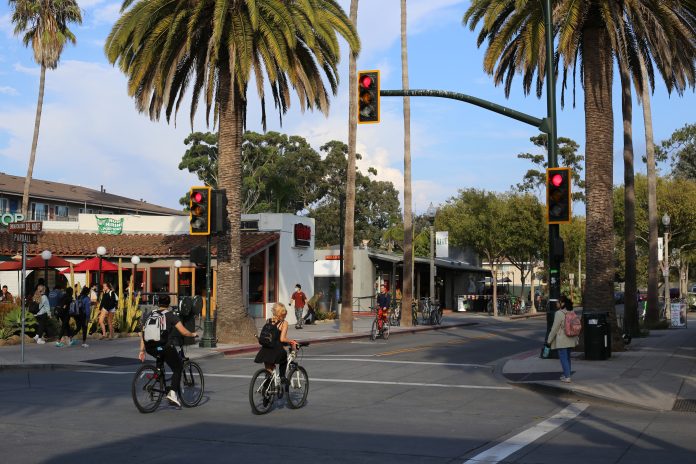Natalie Aymond
Opinions Editor
Jaywalking has been around since cars first started hitting the market. Laws were quick to follow to keep pedestrians and drivers safe, as well as to protect traffic flow. But since then, with more cars and pedestrians urgently filling the streets, jaywalking has become a culture of sorts but with big tickets and fines to follow in some states. California has been one of them, until recently.
California is going to decriminalize jaywalking through “the Freedom to Walk Act” under law AB 2147, signed by Governor Newsom on Oct. 3. In doing so, pedestrians will legally be able to cross the street against light crossing signs or mid-block, as long as it is safe to do so, starting Jan. 1, 2023. In simple terms, if no cars are near and there is no threat of getting hit or being a hazard to an incoming car, you are free to cross the street.
Not only is this convenient for pedestrians trying to move with urgency, but it also eliminates the discrepancy of tickets given out in different neighborhoods and towns. This challenge is one that the Freedom to Walk Act also aims to eliminate, and for great reason. This issue first stems from the fact that there is inconsistent street crossing infrastructure across states which, in turn, creates opportunities for incongruent ticketing and targeting of pedestrians by police.
Not only is this decriminalization necessary, it is also long overdue. The state’s responsibility is to correct and eliminate the possibility for state police to target specific areas, communities, and neighborhoods with hefty fines for jaywalking. This becomes especially relevant when the bulk of those fines occur in under-resourced or low-income areas. This system makes even a seemingly minute law, put in place for street safety and protection, discriminatory.
When we localize what this political action may mean for Isla Vista (I.V.), we first have to shed some light on the jaywalking culture that already heavily exists here and in any college town. At any time of the day, I.V. can be flooded with bikers, cars, and of course, lots of pedestrians. This is not to mention the mess of Del Playa on the weekends and the lack of sidewalks throughout the town. Good luck driving anywhere on that street on any weekend night — I’m sure Uber and Lyft drivers can attest to the madness.
If you are unfamiliar, picture shoulder-to-shoulder groups mobbing down the street being weaved through by bikers and electric scooters. Do you think any of them are worried about jaywalking, especially getting a ticket for it? I think the consequences of public intoxication or an open alcoholic container cross their minds far more than that of jaywalking. They make Del Playa their runway, after all.
Additionally, within those crowds, you have a mixed bag of in and out-of-state students with different levels of aptness to cross the street regardless of where they are. While this is by no means a bad thing and students need not be criticized for the way they have become accustomed to walking, this is something to note when assessing the influence of decriminalizing such a phenomenon in the state. People are already going to jaywalk, especially coming from a town or city where it is like second nature. So, in the long run, it feels arbitrary to direct more police attention and resources on ticketing people for it. Thus the decriminalization of jaywalking should open up California’s police force to direct their attention to, well, more pressing issues (but the accountability for that is a whole other issue).
What is left to discuss, however, is the role of drivers in all of this, as they focus on the streets of I.V. As a driver myself, I do find myself being slightly more on edge and alert when it comes to navigating through the suspicious intersections of I.V., with bikers and beachgoers popping out into the road with no warning. I do feel like it is my job to not hit those people because they are simply not going to have the same awareness as someone behind the wheel. And, well, pedestrians do sometimes think they just have the right to make cars stop for them so they can just cross along, despite it probably being faster for the car to just pass first.
Just the other day, for example, I was trying to turn around on Del Playa, and while pulling into a driveway and backing out (already a tight squeeze), a group of people who had been watching me just stopped me in my tracks and walked behind my car. Obviously, I suspected that they would do that, but there was no hesitation from them that I wasn’t going to stop.
Regardless, drivers should understand the environment they are driving in and what that means for their surroundings. And as I said, for I.V., those surroundings are trifold. Who is to say that the skateboarder who rounds a blind corner and doesn’t have a brake pedal won’t cut off a car to keep on their way? No one. Ultimately, it falls on the driver and gives reason for such conservative speed limits in the neighborhood.
So, does this new law put more responsibility on drivers to be more aware of foot or bike traffic, and even sometimes give pedestrians more freedom to cross unsafely? Yes. But was that responsibility already there even if not enforced, and should it be present even without laws? Also yes.











